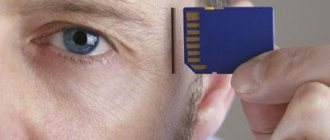Do you know what Kim Peak, Stephen Wiltshire and Daniel Tammet have in common? The first one read a page of text in 4-5 seconds and remembered up to 98% of what he read, and by the end of his life he practically knew 12 thousand books by heart, and remembered maps of all cities and roads in the United States. The second one needs a short helicopter ride over any city in order to draw its detailed plan from memory. The third is a mathematical synesthete who can learn a completely unfamiliar language in a week, perform mental arithmetic operations with numbers of more than 100 digits, and in 2004 he set a European record by reproducing 22,514 decimal places of Pi in 5 hours and 9 minutes. All of them are highly gifted savants with phenomenal eidetic memory.
What is eidetism?
Eidetism (from the ancient Greek εἶδος - image, appearance) is the ability of a person’s memory to remember images, sounds or objects with high accuracy, which is not acquired through mnemonics. According to another definition, eidetics is the ability to voluntarily evoke and retain for a long time exceptionally vivid images of representation that are not inferior or superior in their sensory characteristics to visual images.
This ability to memorize is sometimes called photographic memory. But in scientific research and, in particular, in psychology, the terms “eidetism” and “eidetic memory” are more often used. Perhaps many will note that the concept of “eidetism” is unusual and less known than its synonym “photographic memory”. But this is so only due to the widespread use of the latter in non-core literature. L. Squire, a professor of psychiatry at the University of California, San Diego, is confident that photographic memory, specifically the ability to remember information by “photographing” it, does not exist. As a result of his research, it was proven that not a single person who took part in the experiment, and for this purpose people with extraordinary memory were specially selected, could perfectly reproduce the memorized text backwards. “But it’s easy to do this from a photograph,” the professor sums up. Therefore, the use of the definition “photographic” in psychology is incorrect.
Scientists say that most people are born with eidetic memory abilities. This is especially evident in early childhood (from 2 to 10% of children have developed photographic memory). In the future, with the development of the brain and those parts of it that are responsible for verbal skills, this ability is lost.
The tendency to eidetic memory depends on a number of factors, such as genetics, features of brain development, and strong experiences received. Modern scientists, primarily the cognitive scientist M. Minsky, are skeptical about the eidetic abilities of the human brain. And that's why. In the introduction to the article, we gave examples of people with eidetic memory who, although gifted in terms of memorization, have deviations in other respects (physiology, abilities for social adaptation, etc.). Physiological eidetism, as mentioned above, manifests itself at an early age, and with adulthood it remains as a constitutional trait only in a small number of people. This is often associated with professional activity - eidetism is more common among artists and musicians. But the average person, having an innate eidetic memory, is not capable of achieving the same phenomenal level as some savants. The accompanying myth has been debunked. Thus, chess player and psychologist A. de Groot, who became interested in eidetism as a phenomenon, argued that many people can develop abilities. As an example, he cited chess grandmasters who are able to remember many combinations and scenarios for the development of events during a game. Somewhat later, his experiment was criticized, because such an experiment does not reflect the essence of the entire phenomenon. Moreover, it demonstrates complete failure when it comes to remembering and reproducing other types of information. This partly explains the dislike of many memory development methods for using the concept “eidetic”, although it is used as a synonym.
Development of photographic memory
Irina Koshutina
Development of photographic memory
Development of photographic memory
Lately, we have been watching with affection and surprise the young geniuses who, from TV screens, captivate everyone with their superpowers in memorizing words, numbers, and objects.
Any mother, even an adult, envy these children.
We all dream of being able to remember everything easily, so that just one glance is enough for good memorization. And there is a solution for this.
PHOTOGRAPHIC MEMORY.
In order to unravel the secret of photographic memory , we must understand how, in principle, the memory of each of us .
Our brain consists of 2 hemispheres. Our ordinary memory is the property of the left hemisphere. The natural mechanism of such memory is to learn to forget in order to learn new things. At first glance, it doesn’t sound logical at all, but this is really one of the key principles of our memory .
This principle very often fails us.
In the right hemisphere everything is different.
Unlike ordinary memory, photographic memory captures an image of any scene of life, a book page, a face (any information that can be perceived visually)
just like
a camera
The image does not change over time, and earlier images are not replaced by new ones.
Having a developed photographic memory , a person has direct access to information stored in memory , i.e. he can remember any information from any book he read or pages he saw. Each page is viewed on a screen in the mind, as if it were a snapshot.
The vast majority of people fall somewhere in between and have ordinary memory , with only a few developing photographic memory .
Children under 6 years old are happy owners of the opportunity to EASILY master Photographic memory . Since it is during this period that the right hemisphere is active. And if you do not develop photographic memory , then with age these abilities deteriorate significantly.
The new EDUCATIONAL STANDARD dictates new requirements for our children. Creativity, search for non-standard solutions. This is what is expected from our children.
The child must master 60% of the information himself. We, as lovers, CAN help him with this.
Development of photographic memory ++ our Salvation.
Children, especially preschoolers, love to play. Through play, in an unobtrusive form, the child will be happy to absorb everything new. The right hemisphere is open to knowledge.
According to Dr. Makoto Shichida, the right hemisphere is the part of the brain with which we can imagine and dream. In addition, the right hemisphere can create mental images based on information received from the cells of the body, which is the basis for additional sensory perception. The right hemisphere is responsible for the abilities of the so-called photographic memory .
Japanese professor Makoto Shichida developed games for children to develop photographic memory .
In Shichida's books, the following games for developing photographic memory :
Mandalas
Chain of Memory , method of remembering stories, absurd stories
Memory grid , memory
Memory games
Here are some of these games
Game "Guess what's in the box"
.
In a box (pan, tray, tray or similar container)
place three or four items and cover them with a cloth. For a moment the cloth is removed and the child remembers things, then the box is covered again with cloth. Ask your child to say what was in the box. Gradually increase the number of items placed in the box. Play this game with your child until he can remember 10 objects.
Game “Get the Blocks Correctly”
For this game you will need blocks from the designer of the simplest shapes and different colors. To begin with, it is better to use the same cubes of different colors. Place two levels of a block structure on the floor or table with three cubes on each level. Show the child this design, cover it with a cloth and let the child, using the same exact cubes, reproduce the structure you built. Or you can do this: destroy the constructed structure after you have shown it to the child and let him use these cubes to restore the original one. With this option, you need good memory , but if you doubt this, so as not to forget, you can sketch in advance what kind of structure you want to build and then use this drawing to check the child’s correct restoration of it. Increase the complexity of this game gradually: introduce blocks of different shapes into the design and colors. Eventually the child will be able to remember and recall three levels with five blocks in each level.
Cards “Similar pictures”
How to play
Take 2 similar cards. Show one to your child for a few seconds and remove it. Then take out 2 (or more)
cards and let the child choose which card he just saw.
Game “Memorize and lay out the pattern”
Children are given a ready-made sample to watch for 1 minute. The instruction is given to watch carefully. The sample is then removed. Children use ready-made forms to reconstruct the pattern from memory .
Game “Guess what has changed?”
Children are offered objects or pictures placed or displayed in a row. The child looks at them for 30 seconds, then turns away. Objects and pictures change places. Children turn around and identify the changes. The task becomes more difficult by increasing the number of objects and pictures.
How to develop eidetic memory?
On the Internet you can find many methods for developing eidetic memory, some of which even offer hypnosis. Some yoga exercises are also designed to help improve eidetic skills. The Moscow School of Eidetics and O. A. Andreeva’s School of Quick Reading offer their memory and thinking training based on the development of eidetic perception.
Below we have collected recommendations for the independent development of photographic (as a synonym for eidetic) memory from the popular projects WikiHow and Menprovement. When getting started, remember that eidetism in one form or another is inherent in every person, especially in childhood and adolescence, but in its most striking manifestations it is quite rare. Also, by following these techniques, you will not get a phenomenal memory, but you will improve your natural memory abilities.
Problem overview
While a person with a photographic memory will recall visual information very accurately, a person with an eidetic memory is not limited to visual memories - in theory, she can remember other aspects of the event, including all sensory information: visual, auditory, tactile, gustatory, olfactory , as well as other images. Most debates about the phenomenon of this type of memory agree on the fact that eidetic memory is combined with photographic memory, since the discussion shifts to a discussion of eidetic images (in the sense of “image”); Eidetic memory is visual in nature. After all, a person receives most of the information about the world through the visual system of information perception.
One type of eidetic memory we observe in children is characterized by the individual’s ability to observe an image for 30 seconds and reproduce and retain it in sufficient detail in memory for a short time after the image has been removed from the eyes. Such eidetists claim that they “continue to see” this image before their eyes so brightly and vividly that this image continues to be in front of their eyes.
As is the case with other types of memory, the intensity of the memory depends on several factors: the duration and frequency of exposure to the stimulus, the conscientiousness of the observer, his attitude towards the object of study, and the like. This fact stands in stark contrast to the general misinterpretation of the term as implying the persistence and pervasiveness of memories of past events or the object of observation.
Some people who have a good memory claim to have eidetic memory. However, there are significant differences in the way information is processed. People with a normal type of memory usually use mnemonic techniques (such as dividing a picture they see into elements, linking an idea to a specific object or association, etc.) to retain information in memory; while people with eidetic memory will remember as if a photograph with very specific details: such as the place where the person stood; what the person was wearing, etc.
They remember the event with much more detail - but not in general terms (conceptually, essentially) like an ordinary person. To remember such details, an Eidetic person only needs to make an effort: yes, he seems to be looking closely at the photograph, looking at the details - and does not reproduce these details associatively using mnemonic devices.
Additionally, it is not uncommon for people with normal memory to experience a “sporadic burst of eidetic memory,” where they are able to describe a certain number of memories in great detail. However, this does not work in most cases when a person with a normal type of memory consciously tries to remember the picture in detail.
Reasons for the rarity of eidetism
The rarity of a bright manifestation of eidetism and the suppression of manifestations of corresponding natural abilities in adulthood is associated with several reasons, which were described by academician Alexander Romanovich Luria in his “Little Book of Great Memory”:
- Bright eidetic images in their clarity and detail are not inferior to, and often literally overshadow the image of perception (that is, what is actually happening around a person). For example, when crossing a road with heavy traffic and in a number of similar cases, this creates great problems for the Eidetic, and often a direct danger to the life of himself and his loved ones. Thus, the subconscious mind blocks a person’s eidetic skills in order to protect the person himself from the negative manifestations of the mentioned skills.
- A bright eidetic image is one of the ways to have a very significant influence on the course of physiological phenomena in the body of the eidetic person himself, and sometimes his environment. Alexander Luria, in particular, describes the ability of the test subject to significantly influence changes in the frequency of cardiovascular contractions of his heart, the temperature of his hand, and the like.
It is quite clear that such a powerful weapon in skillful hands can be beneficial, but in unskilled hands it can bring harm to oneself or the people who surround eidetics. By harming the Eidetic itself - these skills naturally reduce the amount of Eidetic in nature.
Awakening and training of eidetic abilities
For many centuries it has been proclaimed that the methods of awakening and training the herdetic abilities have been discovered and used. The most famous example is the numerous branches of yoga; This also includes a number of areas of shamanism, healing, inventive activity, artistic and literary creativity, and the like. Let us note that if the rule of careful selection of those capable of mastering eidetism is violated, gradual and messenger training to competently evoke an image and, no less important, timely release from such abilities (mental dissolution, fading of the image, etc.). There were cases of nervous strain and other negative manifestations, often with serious consequences.
Thus, I. Schultz described numerous cases of schizophrenia with suicide attempts that arose as a result of inept but persistent attempts to evoke eidetic images. Mikhail Zoshchenko described a number of such cases among writers in his book “Before Sunrise.”
As a treatment, I. Schultz suggested re-evoking eidetic images, but doing it wisely. This approach is outlined, in particular, in the work of one of Schultz’s collaborators, K. Thomas. The approach was successful.
Based on this approach, today more detailed methods have been developed for becoming a carefree awakened person, using and training eidetic perception, memory and thinking, which are used in the Moscow School of Eidetics, A. A. Andreev’s School of Quick Reading and a number of other, more closed schools.
Skeptical view of the problem
Much of the controversy surrounding the phenomenon of eidetic memory is based on the fact that in practice this term is applied to almost any case of extraordinary memory. The existence of extraordinary memory skills is quite well documented, they are the result of a combination of innate skills, memorization techniques and extraordinary amounts of knowledge (so sure people are able to remember more than they realize, although for them it is an unrelated set of information - of course a person remembers associatively). And purely technically, eidetic memory means the individual’s feeling of an event, that the individual continues to see, hear, and feel this event (object) in front of him. Almost all claimants to having "eidetic memory" fall outside this narrow definition. Theoretically, it is assumed that eidetic recollection occurs in memory without its processing by memory associatively (i.e., automatic, perceptual processing in memory is not applied, as is the case in an ordinary person; it is assumed that this mechanism is the basis for the work of ordinary memory, otherwise memorization will not occur: the brain will not perceive “gibberish”, it will block such information; eidetics - in theory - simply “photographs” what is seen/heard/felt). Cases of eidetism have been documented and are thus, strictly speaking, very rare, not to say unique. Therefore, a suspicion arises about the absence of such a phenomenon, despite the fact that it is often talked about.
American cognitive scientist Marvin Minsky, in his book The Society of the Mind (1988), considers the phenomenon of eidetic memory as an “unfounded myth.”
An example of the extraordinary memory abilities attributed to eidetic memory comes from Adriaan's popular interpretation of Groot's classic experiments on the ability of a chess grandmaster to remember a set of positions of chess pieces on a chessboard. At first it was found that expert grandmasters could remember a monstrous amount of information, much more than any experts, therefore, in relation to them, the fact of possessing eidetic skills was assumed. However, everything fell into place when expert grandmasters were presented with chess combinations that never appear in the game; their ability to reproduce combinations was no better than that of non-experts; it appears that grandmasters developed the ability to organize certain types of information rather than having innate eidetic abilities.
Much scientific skepticism regarding the existence of eidetic memory was expressed in 1970 by Charles Stromeyer, who examined the abilities of his future wife Elizabeth (she claimed that she could remember poetry written in a foreign language, which she did not understand - for many years when she saw the poem for the first time). She could also apparently recall a pattern from a set of random combinations of dots with such precision that she was able to combine two such patterns in a stereoscopic image. To date, she remains the only person documented to have passed such tests. However, the methodology of the testing procedures used is questionable (especially given the extreme nature of the claims being assessed), as well as the fact that the researcher married his subject, and the fact that the test was never repeated (Elizabeth consistently refused to repeat these studies) ; - All this had corresponding consequences.
A. R. Luria, a Jew by birth, wrote his famous work, “The Mind of a Mnemonist,” about the Jew S. V. Shereshevsky, who was studied with extraordinary memory abilities; Of his many extraordinary abilities, the subject was able to memorize long lists of words and recall them over long periods of time. A. R. Luria believed that a person has an almost unlimited ability in the field of memorization and recall; Shereshevsky, like Kim Peek, was considered an outstanding Savant by 2010. Then it turned out that this Jew used a special memorization technique; he “placed” memorable objects along a section of the Gorky Road; and then, after some time, he “returned” along this road and “collected” these objects one by one. He made a mistake once (for, as he claimed, he placed an object under a white fence and did not notice it when he returned to retrieve the object). This example is a memory training pattern called the loci method - however, it is not eidetic memory.
The next reason to doubt the existence of the phenomenon of eidetic memory is the unscientific event of the World Memory Championship. These annual competitions in many memory disciplines are primarily based on visual tasks (9 out of 10 cases are presented visually, and the tenth example is an audio fragment). Because there are significant prizes to be won at these championships (the total prize fund for the 2010 World Memory Championships reaches $90,000), these competitions should attract people who can easily pass the tests provided (and can easily cope with reproducing visual images of the presented material in memories) . However, no champion has yet been documented to have eidetic memory, although championships have been held since 1990.
Block 1. Lifestyle changes
- Learn to cope with stress. Anxiety, depression and anger have been shown to increase cortisol levels in the brain. This can cause damage to cells in the hippocampus, the area of the brain responsible for storing data in memory.
- Exercise, keep your brain in good shape: don’t put down the newspaper with a crossword puzzle, don’t give up playing board games, study a foreign language.
- Play sports and spend time on physical activity. This way, the brain will receive the necessary oxygen and beneficial nutrients.
- Avoid bad habits. This is especially true for alcohol abuse and smoking.
Relevant products in the Online store:
Dr.
Brandt Needles No More Eye Gel No Bags
from 3,136 rub.
Dr. Brandt
Do Not Age Intensively rejuvenating eye cream with tripeptide for puffiness and dark circles
from 4,802 rub.
Dr. Brandt
Pores No More Mattifying moisturizing gel to tighten pores
from 3,136 rub.
Dr. Brandt
Xtend Your Youth Smoothing Antioxidant Facial Moisturizer
RUB 2,499
sale
All goods
Block 2. Memory strategy
- Eliminate distractions. When studying material that you need to remember, try to organize the process so that nothing distracts you.
- Use visual associations. When remembering information, associate it with images that are easy to remember. One option is the “mind palace” of a modern-day Sherlock Holmes, created by the BBC.
- Repeat. This does not mean memorization, but repetition, which is suitable for remembering a small amount of information at once, for example, a name. The technique is this: after your interlocutor pronounces the name, repeat it to yourself in different forms: Alexander - Sasha - Shurik - Sanya. The second option is to immediately use this name in speech, directly when addressing a person.
- Find more detailed useful information about memory development in the training on our website.
Eidetic memory and its development through games
The developers of trainings and games for the BrainApp service are a team of psychologists, scientists from Moscow State University, and game designers. They all put a lot of effort into making the Brain Fitness online simulators useful for people.
So, for example, the game “Find a Pair” will help train visual and identity memory in the intervals between work or study.
The point of the game is that you need to find 21 identical objects on the playing field. With each round the game becomes more complicated, new elements are added.
Schoolchildren and preschool children will enjoy the game “Memory Matrices”, which trains identic memory in an unobtrusive form.
Playing with matches perfectly develops identity memory. The exercises collected on our website will help you not only have fun, but also spend time usefully with friends or with children.
Reviews and comments
Did you like the article? Have something to share regarding its topic? Join the conversation by leaving a comment below.
We also recommend reading:
- Storytelling
- Intelligence and its development: several recommendations
- "The Language of Memory" by Douglas Hermann and Michael Grunberg
- Cattell-Horn-Carroll theory
- Types of memory and their features
- 5 books that will make you a professional mnemonist
- Visuospatial Corsi test: description and application
- Savantism: definition, characteristics, real examples
- How to train your memory
- Spaced repetition method
- Is it possible to count in your head and remember, like Daniel Tammet?
Key words:1Self-knowledge
Stages of memory development in children
Signs of memory appear already in the first months after birth, when the baby begins to respond to the upcoming feeding procedure. Then recognition is formed: at 3-4 months the baby already remembers a narrow circle of faces and objects. Motor memory develops before the age of 1, and from the 2nd year the first memories appear.
Already from this age you can begin to train your baby’s brain. But since memorization still occurs involuntarily, this must be done in the format of a game with the manifestation of emotions - actively using gestures, facial expressions and demonstrating different moods. By the age of 4-5, the children with whom we studied acquire a large vocabulary and significantly develop an emotional background, due to which memorization through the senses is enhanced. From 4 to 6 years old, children develop voluntary memory; they can already selectively remember exactly what is interesting to them. From 6 to 10, attention actively develops, from 9 the level of intelligence and erudition improves especially noticeably, and the peak period for the development of logic and all properties of memory - its volume, speed of memorization, speed and accuracy of reproduction - is considered to be the age of 10-14 years.
What is visual and photographic memory?
A person receives up to 80% of all information through vision, so developing good visual memory is easier than other types associated with the senses. But all people develop differently, so there are significant individual differences when it comes to memorization. Those who use vision as their main channel of perception are called “visual learners.”
A special case of visual memory is photographic or eidetic memory - the ability to preserve and reproduce visual images with amazing accuracy. Moreover, the eidetic image, unlike ordinary memories, is not associated with emotions and does not depend on mood. Such “pictures” are recorded in the mind as a whole, even without comprehension, and then can be restored down to the details even after a long time.
Many outstanding personalities possessed such a skill. Maxim Gorky memorized pages of text in seconds and could remember books read in this way for many years. Ivan Aivazovsky, before painting his landscapes, peered for a long time at the waves on the seashore, and then could examine them in detail in his mind and transfer them to the canvas. And, although this ability is often called an innate talent, any person can develop it to varying degrees.
The main differences between conventional memory and photographic memory
First of all, you need to understand how ordinary memory differs from eidetic (photographic):
- Conventional memory refers to the filling of free “cells” of the brain with information. As they are filled, previously received information is lost. Memory is filled with new events that carry a brighter emotional coloring.
- Eidetic memory operates with visual images, pictures, regardless of emotions. These pictures do not mix with new images. Even details of previously recorded events are stored in memory.
Conventional memory is a product of the left hemisphere of the brain, photographic memory is a product of the right hemisphere.










